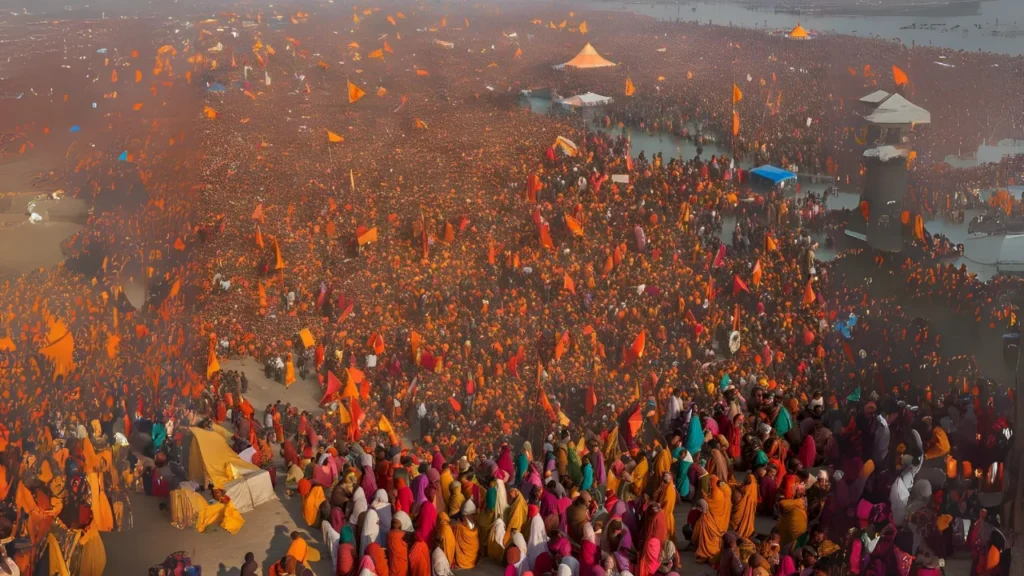The Maha Kumbh Mela 2025, one of the largest religious congregations in the world, is currently underway in Prayagraj (formerly Allahabad), drawing millions of pilgrims to the sacred confluence of the Ganga, Yamuna, and the mythical Saraswati rivers, known as the Triveni Sangam. This once-in-12-years event began on January 13, 2025, and will culminate on February 26, 2025. The festival is a celebration of faith, spirituality, and cultural heritage, attracting devotees, ascetics, and tourists from across the globe.

Basant Panchami: A Day of Divine Significance
On February 3, 2025, the Maha Kumbh witnessed its third major holy bathing ritual (Amrit Snan) on the auspicious occasion of Basant Panchami. Celebrated as the first day of spring, Basant Panchami holds immense religious and cultural significance. It marks the worship of Goddess Saraswati, the deity of knowledge, wisdom, music, and arts. Devotees believe that taking a dip in the holy waters of the Sangam on this day cleanses sins and bestows blessings for success in education and life.
By dawn, over 16.58 lakh pilgrims had already participated in the holy bath, with expectations of 5 crore devotees visiting throughout the day. Saint Chinmayanand Bapu, a revered spiritual leader, emphasized the importance of Basant Panchami for students, stating, “This festival is especially significant for learners. If students take a dip in the Sangam on this occasion, they are bound to achieve success in their endeavors.”
Learning from Tragedy: Enhanced Safety Measures
The Basant Panchami Amrit Snan comes days after a tragic stampede occurred during the previous key bathing day on Mauni Amavasya, claiming the lives of at least 30 people and injuring 60 others. In response to the incident, the Uttar Pradesh government, led by Chief Minister Yogi Adityanath, has implemented stringent measures to ensure the safety of pilgrims.
Since Saturday, CM Yogi Adityanath has been personally overseeing preparations, reinforcing security protocols, medical facilities, and crowd management strategies. Authorities have introduced a structured sequence for various Akharas (spiritual sects) to perform their rituals at the Sangam Nose, the site of the stampede. This step aims to prevent overcrowding and maintain order during the bathing process.
Additionally, government offices in Prayagraj were declared closed on Monday to accommodate the swelling crowds, allowing officials to focus entirely on managing the event.
Praise for Organizers and Leaders
Several seers and sages expressed their satisfaction with the arrangements and praised the leadership of Chief Minister Yogi Adityanath. Acharya Mahamandaleshwar Swami Kailashanand Giri Maharaj of the Niranjani Akhara remarked, “Only a leader who truly understands religion can honor such traditions—and no one embodies this better than Yogi Ji.”
Other sadhus echoed similar sentiments, commending the smooth execution of the bathing rituals and the seamless coordination among authorities. Their endorsements reflect the trust placed in the administration to uphold the sanctity of the event while ensuring the safety of millions of participants.
Record-Breaking Participation
The Maha Kumbh Mela has already surpassed participation records, with over 35 crore pilgrims having taken part since its commencement on January 13. With 23 days remaining until the conclusion of the event, organizers anticipate the total count to exceed 50 crore participants. This staggering figure underscores the global appeal of the Kumbh Mela and its status as a cornerstone of Hindu spirituality.
Upcoming Key Dates of Maha Kumbh 2025
While Basant Panchami marked a pivotal moment in the Maha Kumbh calendar, two more important bathing dates remain:
– February 12 (Maghi Purnima): A full moon day considered highly auspicious for spiritual cleansing.
– February 26 (Maha Shivaratri): The grand finale of the Maha Kumbh, dedicated to Lord Shiva, one of Hinduism’s principal deities.
These dates are expected to draw even larger crowds, further testing the efficiency of the arrangements put in place.
Spiritual Significance of the Maha Kumbh
The Maha Kumbh Mela is not merely a religious gathering but a profound expression of faith and unity. According to Hindu mythology, the event commemorates the celestial battle between gods and demons over a pot of nectar (Amrit), which granted immortality. During this cosmic struggle, drops of the nectar fell at four locations on Earth—Prayagraj, Haridwar, Ujjain, and Nashik—making them sacred sites for the Kumbh Mela.
Each bathing ritual, or Amrit Snan, is believed to purify the soul and liberate individuals from the cycle of birth and death. For millions of devotees, participating in the Kumbh Mela is a transformative experience, offering an opportunity to connect with the divine and seek blessings for prosperity and enlightenment.
Cultural and Social Impact
Beyond its religious dimensions, the Maha Kumbh Mela serves as a platform for cultural exchange and social harmony. Pilgrims from diverse backgrounds come together, transcending barriers of caste, creed, and nationality. The event also provides a boost to the local economy, generating employment opportunities and promoting tourism in the region.
Moreover, the presence of Naga Sadhus, ascetics who renounce worldly possessions and live austere lives, adds a unique dimension to the festival. Their vibrant processions and rituals captivate audiences and highlight the rich tapestry of Indian spirituality.
Conclusion: A Testament to Faith and Resilience
The Maha Kumbh Mela 2025 stands as a testament to humanity’s enduring quest for spiritual fulfillment and collective harmony. Despite challenges, including the recent stampede, the event continues to inspire awe and reverence. Through meticulous planning and unwavering dedication, authorities have ensured that the festival remains a beacon of hope and devotion.
As millions gather at the Triveni Sangam to immerse themselves in its sacred waters, the Maha Kumbh Mela reaffirms its role as a timeless tradition that unites hearts and minds across generations. With each passing day, the event grows in scale and significance, leaving an indelible mark on all who witness its splendor.





